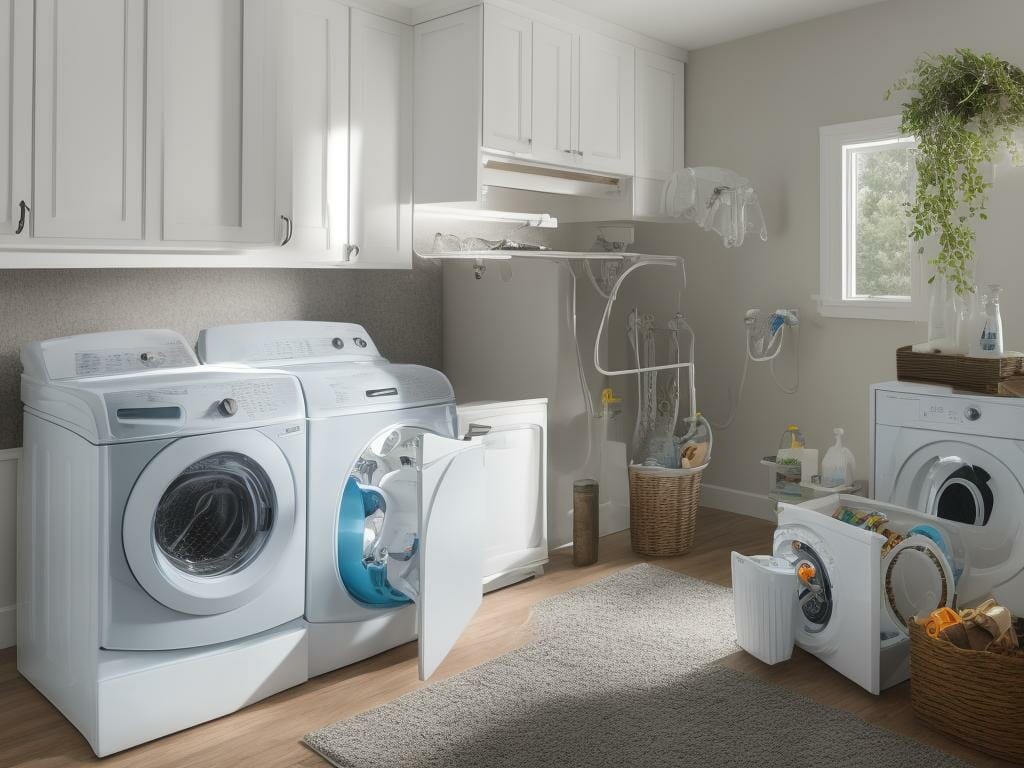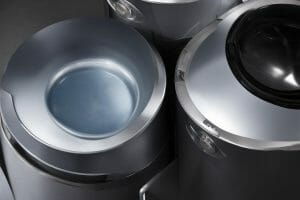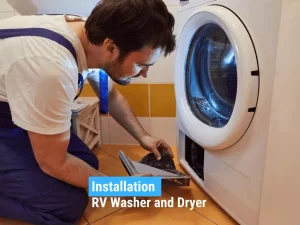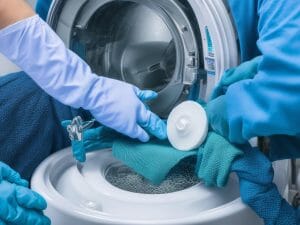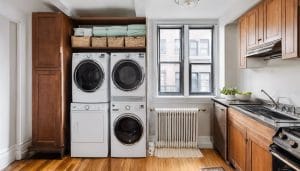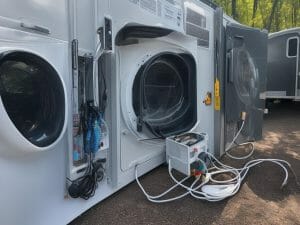How to Install a Washer and Dryer Set in Your Home
Imagine transforming your house into a cozy haven by effortlessly install a washer and dryer set. Like a skilled handyman, you can conquer this task with confidence.
In this step-by-step guide, we’ll walk you through the process of preparing the space, connecting the water supply and drainage, installing the dryer, and ensuring safety.
With our knowledgeable and detailed instructions, you’ll feel a sense of belonging as you complete this home improvement project and enjoy the convenience it brings.
Let’s get started!
Key Takeaways
Preparing the Space and Reading the Instructions
Measure the space for both the washing machine and dryer to make sure they’ll fit properly. Space optimization is crucial to ensure efficient use of the area.
Consider safety precautions when choosing the location for your washer and dryer. Keep in mind that the appliances should be placed on a sturdy and level floor to prevent any potential issues.
Proper ventilation requirements are essential to prevent overheating and ensure optimal performance.
Troubleshooting common installation issues may require reading the instructions carefully and seeking professional assistance if needed.
Connecting the Water Supply and Drainage
Ensure you have a suitable water supply close to the washing machine and securely connect the hot and cold water hoses to the corresponding faucets. This step is crucial to ensure proper water flow and prevent any leaks. To grab your attention, here is a table summarizing the key points for connecting the water supply and drainage:
| Step | Details |
|---|---|
| Water hose connections | Connect the hot and cold water hoses securely to the corresponding faucets and attach them to the back of the washing machine. |
| Proper drainage setup | Set up a standpipe and P-trap for drainage to ensure proper drainage and prevent clogs. |
| Leak testing procedures | Test for leaks by turning on the water supply and checking the connections. |
| Standpipe and P trap installation | Install a standpipe and P-trap to allow proper drainage and prevent any clogs in the system. |
| Water supply proximity considerations | Ensure that the water supply is conveniently located near the washing machine for easy access and maintenance. |
Installing the Dryer and Powering It
To properly connect the dryer, you’ll need to use a metal vent duct or a circular dryer clamp to attach the vent hose. Venting options are crucial for the efficient operation of your dryer. Ensure there is enough space for proper venting and measure it accordingly.
If you have an electric dryer, check the electrical requirements and make sure you have a suitable 240-volt outlet. Gas dryers require the professional installation of a gas line to prevent potential hazards.
Once the vent hose is attached, connect the other end to the wall vent securely. If you’re unsure about the gas line installation, it’s always best to hire a professional.
Following these steps will ensure a safe and effective installation of the dryer in your home.
Installing a Washing Machine Outlet Box
Once you have chosen a suitable location for the washing machine outlet box, securely install it to the wall and connect the supply lines to the water valves. Outlet box placement is crucial for efficient and convenient access to the water supply.
Make sure to shut off the valves before starting the installation process. Carefully follow the instructions provided by the manufacturer to ensure proper shutoff valve installation.
When connecting the water lines, ensure a tight and secure connection to prevent leaks. It is recommended to hire a professional plumber for complex installations to ensure everything is done correctly.
Last, ensure the outlet box is securely attached to the wall to prevent any accidents or damage. Taking these steps will ensure the proper functioning and security of your washing machine outlet box.
Installing a Dryer Hookup and Gas Line (If Applicable)
When installing a gas dryer, it is essential to hire professionals due to the high risk of fire or leaks. Gas line safety should be a top priority, and professionals have the knowledge and expertise to ensure proper installation and minimize risks.
Venting requirements are also crucial for gas dryers, as they need to be properly vented to the outside to remove moisture and combustion gases. This helps prevent the buildup of harmful gases inside your home.
Additionally, professionals can ensure proper electrical wiring for your dryer, whether it is gas or electric. Hiring professional installation guarantees that all safety protocols are followed, reducing the risk of accidents and ensuring a safe and efficient operation of your dryer.
Following Manufacturer’s Instructions for Proper Installation
Make sure you carefully read and follow the manufacturer’s instructions for the proper installation of the washing machine and dryer. This will help ensure a safe and efficient installation process.
Here are some common mistakes to avoid, troubleshooting tips, maintenance guidelines, recommended tools, and safety precautions to keep in mind:
Common mistakes:
- Not measuring the space properly, resulting in an ill-fitting installation.
- Neglecting to level the floor, causing the appliances to vibrate excessively.
- Ignoring safety precautions, such as turning off the power or gas supply before installation.
Troubleshooting tips:
- Check for leaks in the water supply connections.
- Ensure the vent hose is properly attached to prevent lint buildup.
- Test the electrical or gas connections to ensure proper functioning.
Maintenance guidelines:
- Clean the lint filter regularly to prevent fire hazards.
- Check the hoses for any signs of wear or damage.
- Schedule regular professional maintenance to keep your appliances in optimal condition.
Recommended tools:
- Tape measure for accurate measurements.
- Adjustable wrench for tightening connections.
- Level for ensuring a balanced installation.
Safety precautions:
- Follow all electrical and gas safety guidelines.
- Use personal protective equipment, such as gloves and safety glasses.
- Seek professional assistance if you are unsure about any step of the installation process.
Ensuring Safety and Seeking Professional Assistance as Needed
Now that you have successfully followed the manufacturer’s instructions for proper installation, it is crucial to prioritize safety and consider seeking professional assistance when needed.
In this subtopic, we will discuss the importance of proper ventilation, potential hazards, safety precautions, common installation mistakes to avoid, and understanding warranty and maintenance requirements.
Proper ventilation is essential for the efficient operation of your washer and dryer set. It helps remove excess moisture and prevents the buildup of harmful gases like carbon monoxide. Ensure that your dryer is vented to the outside using a metal vent duct or a circular dryer clamp to prevent lint buildup and potential fire hazards.
When installing your washer and dryer, it is important to be aware of potential hazards and take necessary safety precautions. Some common hazards include electrical shock, gas leaks, and water damage. To mitigate these risks, follow the manufacturer’s safety guidelines, turn off the power and gas supply before installation, and test for leaks after connecting the water and gas lines.
Avoiding common installation mistakes is crucial to prevent damage to your appliances and ensure their longevity. Some common mistakes include improper leveling, overloading the washer or dryer, using the wrong type of venting materials, and neglecting regular maintenance. Take the time to read the installation instructions carefully, double-check your work, and follow the recommended maintenance schedule to avoid costly repairs.
While DIY installation can be a rewarding experience, there are instances when consulting a professional is necessary. If you are unsure about any aspect of the installation process, such as electrical or gas connections, it is best to seek professional assistance. Professionals have the expertise and knowledge to handle complex installations safely and efficiently.
Understanding the warranty and maintenance requirements of your washer and dryer set is essential for hassle-free ownership. Familiarize yourself with the warranty terms and conditions, including any requirements for professional installation or regular maintenance. Following these guidelines will help protect your investment and ensure that you can enjoy your washer and dryer set for years to come.
Frequently Asked Questions
What Is the Best Type of Flooring for a Laundry Room?
To create a laundry room that’s both functional and stylish, consider options like vinyl, tile, or laminate flooring. These materials are durable, waterproof, and easy to clean, making them ideal choices for a space that deals with water and potential spills.
Can I Install a Washer and Dryer Set in a Small Space, Such as a Closet?
Yes, you can install a washer and dryer set in a small space like a closet. Consider space-saving washer-dryer options, pros and cons of closet laundry, and maximizing small laundry spaces.
How Do I Properly Level a Washing Machine and Dryer?
To properly level your washing machine and dryer, use a bubble level and adjust the feet until they’re even. This prevents washer vibration and ensures optimal performance. Regular dryer maintenance, such as vent cleaning, improves efficiency.
Are There Any Specific Electrical Requirements for Installing a Dryer?
To properly install a dryer, you need to consider the electrical regulations. Make sure you have the necessary outlets and meet the voltage requirements. Follow safety precautions throughout the dryer installation process.
What Type of Venting System Is Recommended for a Dryer Installation?
Proper venting is important for a dryer installation. Use a metal vent duct or circular dryer clamp for secure attachment. Common mistakes include using plastic vents and not cleaning the vent regularly. Follow safety guidelines and regulations for a safe installation. Consider upgrading your dryer vent for improved efficiency.
Conclusion
In conclusion, you’ve successfully installed your washer and dryer set in your home! By following the step-by-step guide and taking the necessary precautions, you’ve created a convenient and efficient laundry space.
Remember to always prioritize safety and seek professional assistance for complex installations.
Now, sit back and enjoy the satisfaction of knowing that your laundry needs are taken care of with the utmost expertise.
You’re now the master of laundry, the conqueror of cleanliness, and the ruler of fresh-smelling clothes!

